Destination Stewardship Report – Autumn 2021 (Volume 2, Issue 2)
This post is from the Destination Stewardship Report (Autumn 2021, Volume 2, Issue 2), an e-quarterly publication that provides practical information and insights useful to anyone whose work or interests involve improving destination stewardship in a post-pandemic world.
Resurrected Matera Faces Overtourism
Inviting Hollywood into your home can backfire badly. Often, a roaring success on the screen may cause instant, irreversible collateral damage to the destination, its culture and citizens. Arild Molstad explores the too-much, too-fast story of Italy’s ancient, now-restored town of Matera.
Once Called “the Shame of Italy,” Matera Grapples with Modernity, UNESCO, and James Bond
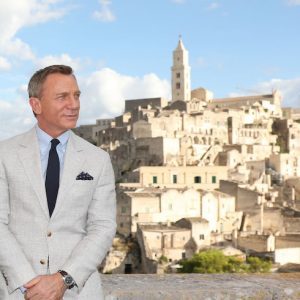
Daniel Craig poses in front of Matera’s famous cathedral while taking a break from filming his new James Bond movie, No Time to Die. [Photo courtesy of Esquire Middle East]
Hard to find – and for those who knew its awful past – easy to keep hidden in the Sassi Gorge (Italian for “stones”), Matera fills a narrow ravine where its stacked dwellings, churches, and monasteries were carved into the limestone.
Had somebody in the 1950’s told the poor, overcrowded, and undernourished inhabitants of Matera that their children and grandchildren would be living in a site inscribed on UNESCO’s World Heritage List (1993), they would have been laughed out of town. The Sassi, which once housed 20,000 inhabitants, was reduced by then to around 1,500 people – still today’s population.
The Town that God Forgot
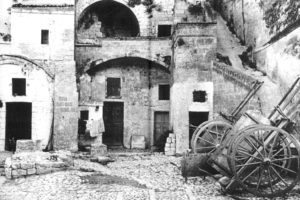
Matera was first caught in the global spotlight before World War II, when Benito Mussolini’s regime deported a young anti-fascist artist to this desolate town, where he could do the regime no harm. Instead, Carlo Levi wrote Christ Stopped at Eboli, shocking the world. Photo: atp.basilicata.it
It was only in 1986 that the Italian government, with World Heritage status in mind, decided to invest serious money into the rehabilitation of Matera. A handful of years later rumours about this unique site started slowly to circulate. Its position – deep in Italy’s Mezzogiorno region and off the beaten track – was the reason that early visitors called it “a hidden treasure.” Even backpackers exploring the triangle between Naples, Rome, and the Adriatic port of Bari missed it.
When I found myself at the edge of the Murgia plateau in 2021, staring speechlessly down at Matera’s unique network of caves, churches, and alleyways, I was looking at what is said to be one of the three oldest continuously inhabited towns on our planet (the other two: Aleppo and Jericho).
For an absorbing half-hour video presentation of Matera’s history, today’s visitors flock to Casa Noha, an interactive museum housed in a former palazzo. Here I was to learn the long and dramatic journey Matera had taken, from abject poverty during two world wars, to winning European Capital of Culture status in 2019.
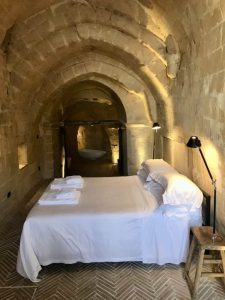
La Grotte della Civita: one of the exclusive, repurposed cave dwelling boutique hotels by owner and conservationist Daniele Kihlgren. Photo: atp.basilicata.it
Dangerous living conditions, poor sanitation and disease forced residents to abandon the Sassi after World War II. The writer Carlo Levi, an anti-Fascist writer exiled to the region by the Mussolini regime, compared Matera to Dante’s Inferno in his immortal book, Christ Stopped at Eboli. Matera became known as “the shame of Italy’’ as its hapless, suffering inhabitants succumbed to malnutrition and water-borne diseases at the bottom of the ravine.
Levi’s book, a heart-breaking wake-up call to Italian authorities, was also filmed here. Wrote Levi: “To this shadowy land, that knows neither sin nor redemption from sin, where evil is not moral but is only the pain residing forever in earthly things, Christ did not come. Christ stopped at Eboli.”
Comes the Resurrection
The restoration of Matera begun in the 1980s was partly hard labor, partly an outstanding artistic and architectural achievement as the wild, limestone canyon prepared for the coming of more visitors. “It was a sight to behold,” sighs Gianni, a local filmmaker. “Now tourism is outpacing us, year by year, in our efforts to safeguard Matera’s authenticity and integrity.”
In the street, older inhabitants had stories to tell of those who left, and how they refused to return to face the old town’s sudden prosperity. To them, it brought back dark memories of desperation and ignominy. All complained about tourism-driven higher housing and grocery prices. “Where are the benefits?” they asked as Matera received a record-breaking one million visitors in 2019.
UNESCO Inscription Requires Protection and Management
Numerous laws, plans, statutes, institutions, and departments to safeguard Matera came into being when Matera was accorded UNESCO World status in 1993. Later, a management plan was drawn up to address tourism and visitation challenges in the historical area.
The Municipality established a special department, “Ufficio Sassi,” in collaboration with several local offices of the Ministry for Cultural Heritage and Activities, recognizing “the need for vigilance in respect” to prevent “negative impact to the development in the buffer zone between the ancient quarters and the modern town of Matera.” I wonder: Has this turned into a bureaucratic maze, to be exploited by fast-money investors with little time for conservation? –A.M.
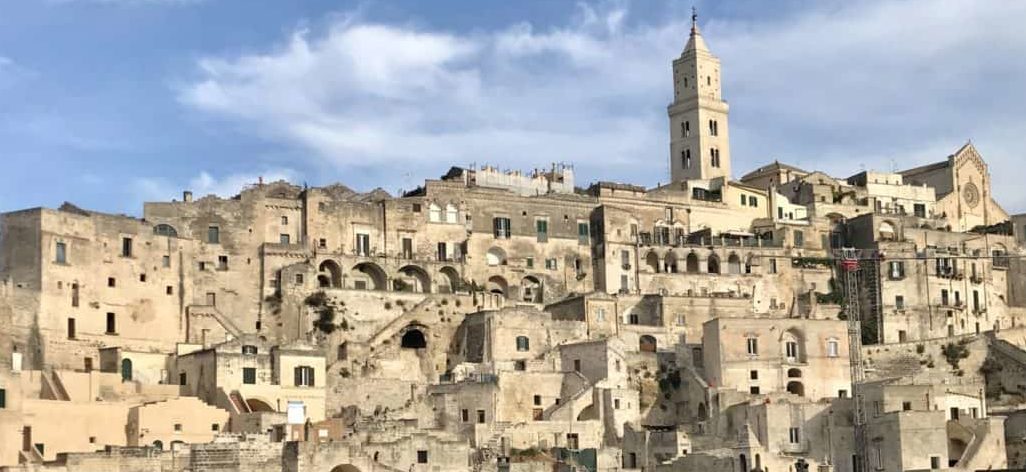
Matera by day. Photo: Charlotte Molstad
Matera – A Movie Set
Matera’s appearance has often been compared to a movie set. It is hard to disagree, as I rise early to watch the sun embrace the town’s facades, adding patches of orange and deep shadow to the Sassi Gorge down below, from which only the soft sounds of street sweepers and somebody strumming a guitar emerge.
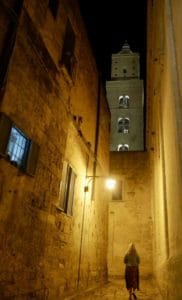
Matera by night: Wonderfully spooky golden light falls on a maze of streets. Photo: Arild Molstad
Connoisseurs of movie classics will recognize Matera – known as “little Jerusalem” in films by famous directors such as De Sica, Visconti, Pasolini, the Taviani brothers, and Mel Gibson’s controversial The Passion of Christ.
My terrace is only a stone’s throw away from a film location shot near the cathedral – a film now being watched by millions of James Bond fans all over the world, as Daniel Craig, in his slick, souped-up Aston Martin, performs impossible hairpin turns in the narrow alleyways and steep staircases. I’d hired a guide to Sassi’s secret hideaways, who suggested that the title of the film, No Time to Die, might be a fitting headline for “an editorial in the local newspaper to help save Matera’s priceless treasures.” He was referring to the numerous unique, fragile cave paintings depicting scenes from the holy scripture.
Others were more direct. The manager of high-end boutique hotel (who spoke on the promise of anonymity) decried the recent wave of “too many restaurants, bars, arts and craft shops, guides that are not ambassadors of this beautiful town, or neglect to respect rules and regulations.” He said, “Residents who moved back in the 90s are now leaving the historical center.” They fear further exploitation and commercialization.” Surely not an unknown phenomenon in UNESCO sites such as nearby Naples or in Sicily – not to mention Venice.
Taking on 007
During my stay, I spoke to others who would welcome a “007 workshop” – to be convened urgently, similar to a town meeting held in 2019, during the Capital of Culture festivities. Already at that time, prominent local leaders were expressing concern about the tourism onslaught, led by Raffaello De Ruggieri, then mayor, who famously told New York Times, “We don’t want tourists,” adding, “it could deplete a city of its soul.”
On my last evening, the view from my terrace transports me deep into history, bringing to mind Carlo Levi’s words: Matera “seemed to melt away, as if it were sucked back into time ….”
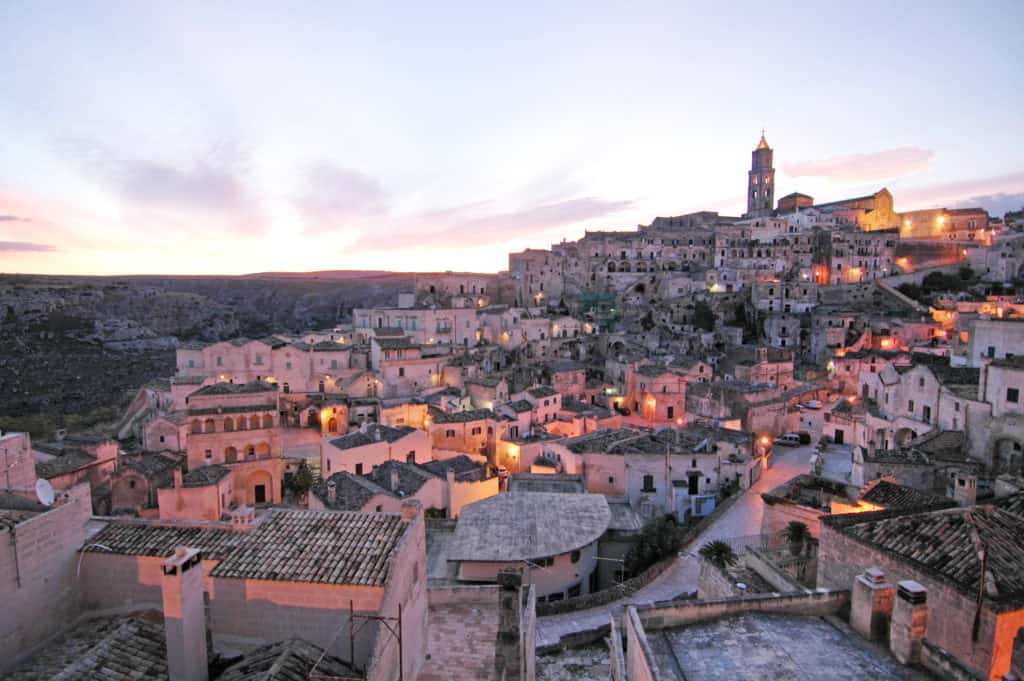
Evening comes to the Sassi Gorge of Matera. Photo: Arild Molstad
A potent cup of espresso kicks me back into the present. With Daniel Craig as Matera’s unofficial, possibly reluctant tourism ambassador, will the film’s spectacular sky dive into the shadows of the gorge spell the end for this still authentic, well-preserved UNESCO site?
The current mayor prefers to take an optimistic view of the worldwide attention that the Bond spectacle can bring to a place still reeling from the pandemic. In a way, I understand. The Matera of today looks and feels like a treasure chest, filled with vitality, culture, priceless traditions, shared heritage – and a need to survive. Its story continues. Clearly, Matera has sent me on my way with an arrivederci – “until we see each other again.”
About Arild Molstad
Author, photojournalist, conservationist, consultant www.arildmolstad.com




